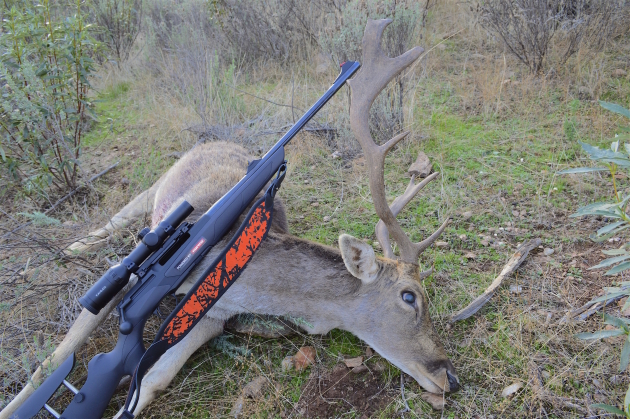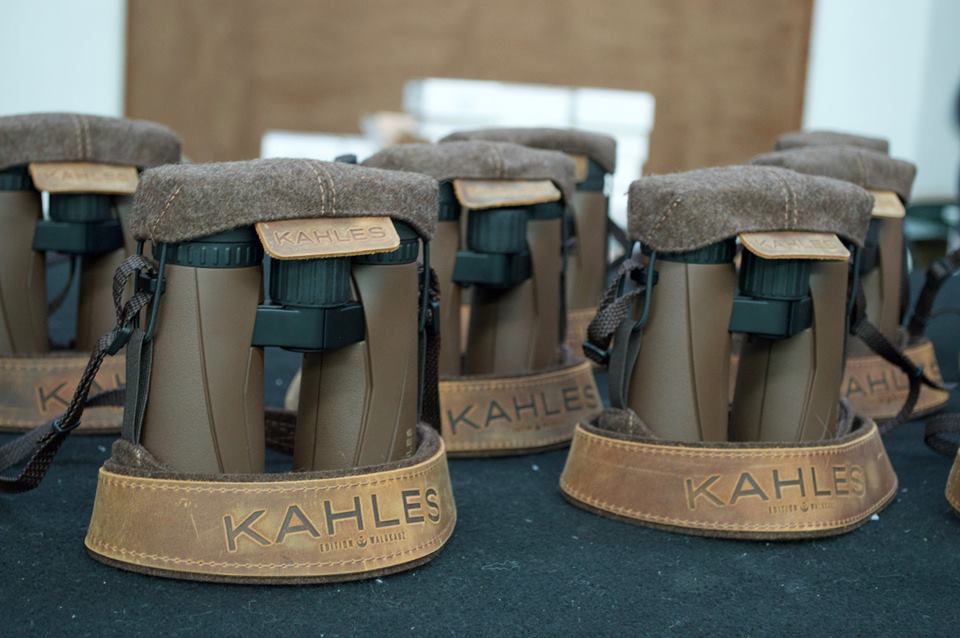I can honestly say that, had it not been for my Kahles scope and binoculars, there’s no way I could have made successful shots on my recent monteria in Portugal. A monteria is an Old-World driven hunt, the sort that requires quick shooting and even faster follow-up shots. With thick brush and few clear shooting lanes, hunters must be ready for a shot at any moment, at any distance.
True, iron sights can be used in these difficult circumstances. My Merkel RX Helix was equipped with fiber-optic front and rear sights, but, fortunately, my computer-weary eyes weren’t forced to use them. Instead, my rifle was topped with a Kahles Helia 5 1-5 x 24i. The “i” stands for illuminated, with the scope featuring a red dot where the crosshairs meet. The dot could be turned off and the traditional crosshairs used, but I never saw any need for doing so, even in the bright sunlight of my first day of hunting.
We started out our two-day adventure with a fallow deer drive. I was set up on one hillside with the vast majority of deer and dogs coursing across the opposite rise. In decidedly un-monteria fashion, I sat down for a steadier shot and cranked the scope to 5. Having that extra level of magnification came in mighty handily when I took my first fallow buck—my first European animal ever—at 125 yards or so across the valley.
Could the shot have been made with less magnification, or without a scope at all? Yes, but that extra level of clarity and precision let me confidently shoot out a deer’s heart at more than a football field away. If accuracy and clean kills really are the goal, choosing a low-powered, variable scope is the way to go.
Not long after that came chance for me to crank down the magnification a bit and inspect an approaching noise. Something was coming through the brush—fast—not more than 20 yards below me. The vegetation was so thick, though, that I could barely make out a shape, much less a species. Had I been relying on iron sights, worrying about lining up rear notches and front posts, I might have mistakenly shot the dog that broke cover as I settled the Helia’s crosshairs on the narrow shooting lane. Instead, I could clearly see the brown hide of the mutt when he stepped into the space hardly as wide as a man’s shoulders. That simple act of putting a magnified dot on a dog helped me concentrate on what I was shooting, not the mechanics of making a shot.

Shot through the heart, and Kahles is to blame.
Kahles has promoted the Helia 5 as “optimized for the driven hunt.” That it is, as my second day of hunting proved. Gone were the open hillsides and plainly visible deer, replaced by black boars and the rankest growth of trees, grass, and bushes imaginable. I had to constantly adjust from 1 to 5 power as different hogs presented themselves, some far away, some danger-close.
One hog nearly ran into me—over me, through me—as the morning’s hunt progressed. A gigantic sow, bigger than any of the boars we saw that day, came racing over the hill opposite me and straight down to the valley between. She came within a hair’s breadth of coming directly up my side of the vale, but a last-second shift to the left let her pass down the valley and away from me. The scope, which had been set at a magnification between 2.5 and 3 when she first appeared, was at a tense 1 by the time she turned away.
The boar I ended up killing was running at a breakneck speed from left to right across an adjacent hillside. I could have shot it at a setting of 1, but with the dogs hot on its trail, I went for a 3-power setting to ensure I didn’t misjudge the lead and hit a dog by mistake.
I was curious as to what role binoculars would play in a monteria. After all, everything was either running by or at you. What difference did it make whether I could see them at 300 yards away or not if they were only going to be 30? At that range, I needed to be looking through a scope instead of binos anyway. Right?
I was dead-wrong, as the binoculars were probably my favorite piece of gear on this hunt. (High praise considering the equipment I was using.) The Helia 8×42’s light transmission, a quality that is often hyped but rarely delivered on by manufacturers, was nothing short of phenomenal. Antlers shone in the Portuguese sun; hairs bristled as hogs paused to backtrack behind the passing line of dogs. I have never been an optic snob, but I quickly became one after looking through these binoculars.
I spoke to Josef Kampfer at dinner that night about my first impressions on the Helia binos. The optics were a passion project for Kampfer, head of marketing and PR for Kahles. I told him that while I loved the scope and its performance, it was the binoculars that had really solidified my high opinion of Kahles.
He surprised me by saying that many had told him the binos would never find a place in the U.S. market. Too many options available from competitors already; too high a price tag (roughly $1,000 retail). “Who would want them?” the naysayers said.
I do. And so will anyone else who values quality.
To view these and other great products from Kahles, visit their website today.

